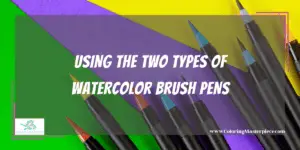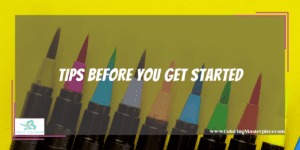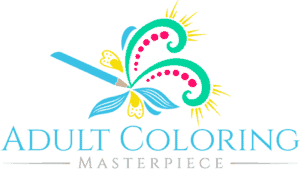Watercolor brush pens are a fun medium that has become quite popular for lettering, drawing, mimicking traditional watercolor paints, and—my personal favorite—inking in-line drawings.
Watercolor brush pens have synthetic brush tips and come in two varieties: one with an empty reservoir for water or one that comes pre-filled with ink. The first type works similar to a paintbrush, except the water is contained inside the pen. The second type is more similar to a marker with wet and water-soluble ink inside.
Both types are highly portable with easy cleanup, making them an excellent option for quick projects or art on the go. They also offer excellent control that you’d associate with a pen or marker, and the brush tips can create different widths by merely changing pressure.
Using the Two Types of Watercolor Brush Pens

These two types of watercolor brush pens have a lot in common and are often used in conjunction with one another. They do operate a little differently, though, and have some differences in techniques and maintenance.
Fillable Watercolor Brush Pens
One type of watercolor brush pen (sometimes referred to as a “water brush pen”) comes with a reservoir that you fill with water at each use. They can be dipped in dry or wet watercolor paints just like a brush, except the water flow can be controlled with a gentle squeeze of the pen. The reservoir can also be filled with liquid paints, ink, alcohol for diluting alcohol inks, or a mix of water and dry pigment. This watercolor pen operates very similarly to traditional watercolor paints; only the water is contained inside the pen rather than needing to be dipped into a cup. They are also shorter than most paintbrushes and have a cap to protect the tip, so they’re easier to take on the go!
It’s relatively easy to create either blended washes or smaller details and vary the concentration of paint on the paper with some practice. These brushes can also be used with other water-soluble mediums, like water-soluble colored pencils. Just like paintbrushes, they can be purchased with a variety of brush shapes and sizes, and typically they come with 2 to 10 pens in a pack. Unlike some paintbrushes, watercolor brush pens usually come with synthetic bristles.
Watercolor Brush Pens with Ink
Colored watercolor pens work a little more similar to markers but have a brush tip rather than a felt tip. They come pre-filled with ink, which makes the concentration of pigment applied to the paper more consistent but gives the artist less control than traditional watercolors.
The pens can be dipped in water to dilute the ink, two pens can be touched together to blend colors, or blending can be done on the page by scrubbing and layering colors. The pens can also be blended with water, or applied by a refillable watercolor brush pen or a traditional paintbrush.
The brush tips are usually tapered to a point and allow the artist to vary their stroke width by changing pressure. This feature makes them quite popular for lettering because the pens allow for wide downstrokes and narrow upstrokes.
Watercolor brush pens usually come in vibrant colors, and packs vary in size—typically between 20 and 100 pens. Many packs also include refillable blending brushes. Some are even refillable—with ink sold separately, so you don’t have to throw your pens away when the ink runs out.
Of course, just like any marker or paintbrush, your pens won’t last forever. Over time, the tip will wear out, and the pen will need to be replaced eventually. How soon depends on the quality of the pen, the frequency of use, how rough you are with it, and the paper’s texture.
Tips Before You Get Started

There are a few tips and tricks you might want to master before purchasing watercolor brush pens or diving into your first project.
Buying the Right Pens
If you want to buy a pack of watercolor brush pens, try to look for one with a refillable clear water pen, so you don’t have to purchase it separately. The size of the pack you choose is up to you and depends on your budget and how many colors you need. You should check reviews for a brand’s juiciness (how readily the ink flows) and how much the pens move and blend once dry. Some watercolor brush pens will be relatively steadfast once dry, while others will reactivate and blend easily when re-exposed to water. Which one you choose will depend on the desired effect for your project.
Using the Right Paper
Just like watercolor paints, watercolor pens are a very wet medium. This means you need an appropriate paper to prevent wrinkling, buckling, and other damage to your work. Watercolor paper is specifically designed to be thick and absorbent to withstand water exposure. A less durable paper might work for projects that don’t need many colors, like lettering. But if you’re going to be filling in areas with color, layering colors for blending, or creating washes, you’ll likely want to work with hot- or cold-press watercolor paper.
Hot-press watercolor paper will offer you a smoother surface, great for lettering and inking projects. Cold-press watercolor paper will have a more textured (or “toothier”) surface, which creates a textured, visually exciting piece. This type may be better for washes and a more painting-like approach to the pens. Watercolor is a transparent medium, so your colors will show up best on white or ivory paper. Some watercolor paper comes in different tones, but it is warned that these will mute your finished work’s vibrancy.
Practice First
Before you start your first project with watercolor brush pens, you may want to play a little and test how the pens flow and blend. Each brand varies slightly, so take the time to see how they react with water or with each other. Be careful not to rub the paper too hard, or you can damage the paper or the brush tip. Also, pay attention to how long the pens take to dry. This will depend on the brand, the amount of liquid applied, the type of paper used, and the temperature and humidity in the room. Scrubbing one area repeatedly while it’s still wet can cause damage, even on the most durable of papers, and applying ink over a still-wet area can cause unwanted bleeding.
Mixed Media
Watercolor brush pens can be used with other media to create more detail, texture, or deeper colors. Colored pencils, markers, waterproof pens, and traditional watercolors can all enhance your artwork. Just be sure to keep in mind that water-soluble mediums will run or bleed if exposed to water or wet ink from a watercolor brush pen. Also, be careful not to use mediums requiring rubbing—like colored pencils—on wet areas of the paper, which can damage your artwork.
Cleaning and Storing Watercolor Brush Pens
Watercolor brush pens that contain ink should be stored either horizontally or upright with the brush side down. This helps keep the tip moist and ready for the next use. Always make sure the cap is on securely to avoid leaks or to dry out. Water brush pens with a water reservoir should be cleaned regularly. To clean pigment out of the brush, squeeze water out of the pen while brushing the tip-off on a paper towel until the water comes out clean. (This technique can also be used for switching colors.) Over time, some staining of the tip is normal and is harmless as long as the water comes out clean. Smooth the bristles to a point before storage.
Learn more about watercolor brush pens here!
Frequently Asked Questions
1) What are some good project ideas for watercolor brush pens?
The possibilities for watercolor brush pens are virtually endless—they can do almost everything that watercolor paints or markers can do—but the vibrant colors and tapered brush tips lend themselves to specific projects. A few things you might want to try: lettering, florals, brightly colored animals, inking cartoons, and making cards!
2) Can I use watercolor brush pens in coloring books?
It depends on the paper thickness of the coloring book. Coloring books with thicker pages are great for use with watercolor brush pens. Still, some coloring books with thinner pages—like those intended for use with dry mediums like colored pencils—will likely experience bleeding, running, wrinkling, or surface damage.
3) What if I want less vibrant colors with my watercolor brush pens?
If you buy a pack of vibrant watercolor brush pens and need to mix a more neutral color, you can try blending two complementary colors to create browns or greys. The blending of two colors can be done either by touching the bristles together for a few seconds to mix the ink or applying them directly to the paper and mixing with a refillable water brush pen. You can also mix the ink with water on a plastic palette or a piece of cellophane.
Ready to get started? Click here to download my free adult coloring eBook and sign up for my email newsletter!
Disclaimer: The information provided by ColoringMasterpiece.com (“The Site”) is for general informational purposes only. All information on the Site is provided in good faith, however, we make no representation or warranty of any kind, express or implied, regarding the accuracy, adequacy, validity, reliability, availability, or completeness of any information on the Site. Under no circumstance shall we have any liability to you for any loss or damage of any kind incurred as a result of the use of the Site or Reliance on any information provided on the Site. Your use of the Site and your reliance on any information on the Site is solely at your own risk. This blog post is for educational purposes only and does not constitute legal advice. Please consult a legal expert to address your specific needs.
Terms and Conditions: https://coloringmasterpiece.com/terms-and-conditions/

